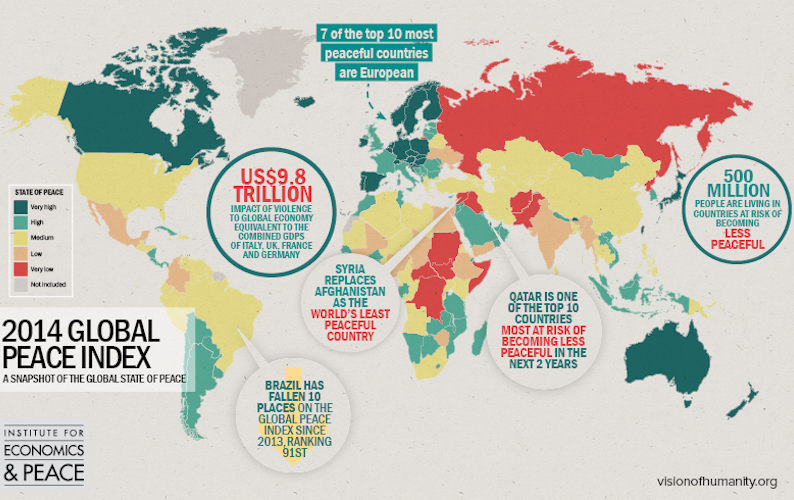Global Peace Index 2014
Yesterday the Institute for Economics and Peace (IEP) released their annual ranking of 162 countries’ in terms of their peacefulness—the Global Peace Index (GPI). The GPI is in its eighth year running, and for the seventh year running they have found the world’s peacefulness in decline.
Declining levels of peace
The historical measures of GPI have shown that 111 countries have declined in their level of peace, and only 52 have improved since 2008.
Seven of the top 10 most peaceful countries are in Europe, and Iceland remains most peaceful. Syria has replaced Afghanistan as the world’s least peaceful country.
“Our research shows that peace is unlikely to flourish without deep foundations,” says Steve Killelea, Founder of IEP and Vision of Humanity, “This is a wakeup call to governments, development agencies, investors and the wider international community that building peace is the prerequisite for economic and social development.”
Economic impact of violence:
While violence obviously has a serious impact on people’s lives, we don’t always think about the economic costs. IEP found that the global impact of violence is 11.3% of global GDP or $US 9.8 trillion.
The world would not only be a better place without violence, it would also be wealthier and more sustainable for all its inhabitants. Imagine if this money was invested into sustainable energies, education and training in entrepreneurship—for people in all countries! What a different world we could create.
Global Peace Index interactive map: http://bit.ly/GPI2014
Global Peace Index report: http://bit.ly/GPIreport
Global Peace Index Video: http://bit.ly/GPIvideo
Based on what?
The GPI is based on the measurement of 22 indicators:
- Level of perceived criminality in society
- Number of internal security officers and police per 100,000 people
- Number of homicides per 100,000 people
- Number of jailed population per 100,000 people
- Ease of access to small arms and light weapons
- Level of organised conflict (internal)
- Likelihood of violent demonstrations
- Level of violent crime
- Political instability
- Political Terror Scale
- Volume of transfers of major conventional weapons, as recipient (imports) per 100,000 people
- Terrorist activity
- Number of deaths from organised conflict (internal)
- Military expenditure as a percentage of GDP
- Number of armed services personnel per 100,000 people
- Financial contribution to UN peacekeeping missions
- Nuclear and heavy weapons capability
- Volume of transfers of major conventional weapons as supplier (exports) per 100,000 people
- Number of displaced people as a percentage of the population
- Relations with neighbouring countries
- Number of external and internal conflicts fought
- Estimated number of deaths from organised conflict (external)
Stay in touch with the Global Peace Index:
Twitter: @GlobPeaceIndex #PeaceIndex
Facebook: Global Peace Index



